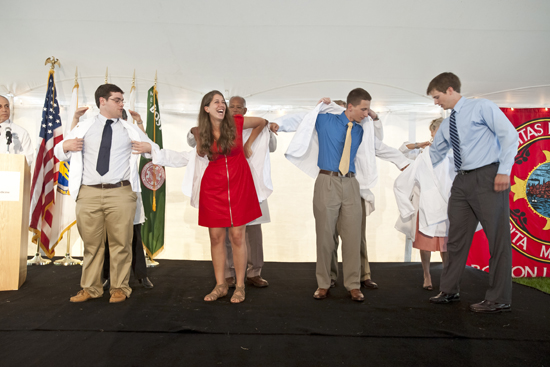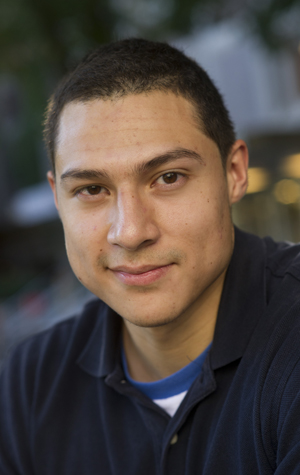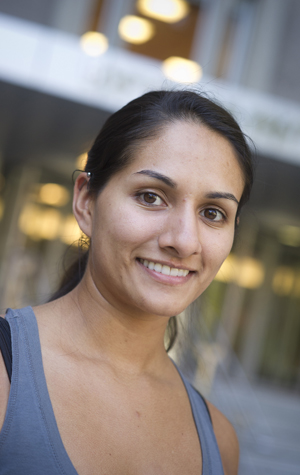Who Wants To Be a Doctor? And Why. New BUSM students reflect shifting medical landscape

Who wants to be a doctor?
The BU School of Medicine Class of 2015 is being groomed for a respected profession now in financial upheaval and plagued by what many believe is a worrying trend away from the traditional, often nearly lifelong doctor-patient relationships nurtured by primary care. But despite concerns about health care access and future loan debt, interviews with incoming MED students reveal optimism about a career that will enable them to serve not just their patients, but their communities.
Plucked from 11,400 applicants, the 173 members of the new class hail from 32 states and 19 nations. On August 8, at the storied White Coat welcoming ceremony, they recited the Hippocratic Oath, and then, lest the proceedings get too solemn, were reminded by Kitt Shaffer, a MED professor of radiology, that “being a doctor is the best job on the planet,” and that “if you’re not having fun, you don’t have the right attitude.”
And then the grind began. Already confounded by the demands of gross anatomy, many first-year medical students are eyeing specialty medicine right off the bat—it’s not uncommon for even premed students to be planning careers not just in, say, orthopedic surgery, but in hand surgery.
 Heather Dehaan (MED’15): “Today’s doctors are seen as being more humanitarian, and more involved with public health.” Photo by Vernon Doucett
Heather Dehaan (MED’15): “Today’s doctors are seen as being more humanitarian, and more involved with public health.” Photo by Vernon Doucett
“I always worry about people having a fixed idea so early, making decisions based on a very incomplete understanding of themselves,” says Robert Witzburg (MED’77), a MED professor of medicine and associate dean for admissions. But in recent years, says Witzburg, MED and other medical schools that had routinely selected applicants most adept in the sciences are now choosing students based on a more holistic review.
“That changes everything about the admissions process,” Witzburg says. “It creates a structure in which every element of the application is considered in the context of every other element. The academic record is no longer looked at as a stand-alone item, but rather in the context of the applicant’s life experience, the adversities he or she has faced, the advantages he or she may have had.”
He says adopting the holistic approach is part of an effort to “educate more students interested in community health and primary care specialties.” But, he says, “in essence we just don’t know yet.”
While he acknowledges the need for specialists, Witzburg echoes a growing sentiment in his profession that primary care is slighted by the payment system, and accumulating medical school debt is pushing young doctors toward the more lucrative specialties. Because doctors are compensated more for procedures like diagnostic scopes, scans, and biopsies than for services such as counseling or dispensing prescriptions, core primary care services are difficult to quantify and reimburse. The income gap between primary care doctors and those in subspecialties has grown steadily in the last decade, with a difference in median income of as high as $250,000 between primary care physicians and those practicing diagnostic radiology and orthopedic surgery, according to a report by the Robert Graham Center , which surveyed doctors’ incomes between 1979 and 2004. The disparity is seen as the main cause for a drop, by nearly one half, in the odds medical students will choose primary care. And the report estimated a drop of 30 percent in the odds a student will end up working in a rural health center.
 Javier Rios (MED’15): “I feel like, even during residency, you can have time for your family.” Photo by Vernon Doucette
Javier Rios (MED’15): “I feel like, even during residency, you can have time for your family.” Photo by Vernon Doucette
The dramatic decline in primary care is compounded by an aging U.S. population and the expansion of health care access under the 2010 Patient Protection and Affordable Care Act, often referred to as Obamacare. A report by the American Academy of Family Physicians predicts a shortfall of almost 40,000 primary care providers by 2020. At the same time, the American Association of Medical Colleges estimates that among 2010 medical school graduates, average debt was almost $160,000, almost double the $87,000 in debt for graduates in 2002.
“There’s no doubt that students and residents tend to gravitate toward highly lucrative careers that are respected by their colleagues,” says Witzburg, an internist who as a young man turned down a prestigious cardiology fellowship. “And it’s common for people to turn their noses up at primary care after looking at primary care doctors struggling with paperwork and being paid poorly, and seeing other people doing high-class procedures, making disease go away in 60 minutes and being very well compensated for it. It’s not lost on medical students that these specialists are sought after by hospitals, have big fancy offices and big fancy cars, and live a different life than primary care doctors.”
Lifestyle issues
But it’s not just concerns about income that is causing the shift in the medical landscape, he says. There are lifestyle issues—dermatology and ophthalmology, for example, have virtually no emergencies. Writing in the New York Times, surgeon Karen S. Silbert recently made waves by suggesting that women who want to work part-time—there’s an increasing trend for doctors to split jobs—should choose a profession other than medicine.
Heather Dehaan (MED’15), a University of Miami graduate from Nashua, N.H., thinks the attraction to lucrative specialized medicine has started to wane. “Today, doctors are seen as not being so selfish,” she says. “Doctors are seen as being more humanitarian and more involved with public health.” Dehaan hopes to be a pediatrician and is attending medical school on a U.S. Navy scholarship. Her lifelong resolve to be a doctor was strengthened as a college freshman, when her much younger sister became ill with cancer. “Caring for my sister reconfirmed what I already wanted to do,” she says. A biology major, she’s always wanted to work with children and believes that a career in pediatrics will afford her “the most influence and the most input” toward bettering kids’ lives. Under the terms of her scholarship, she’ll serve one year as a doctor in the Navy, beginning as a lieutenant, for each year of medical school. “I’m not going into this with the expectation of making a lot of money,” she says. The income question hasn’t come up in discussions with residents and fellow students, she says. Dehaan is engaged and would like to have children some day, but that will have to be put on hold until some point in the future. “And I’m okay with that,” she says.
 Matthew McAdams (CAS’10, GRS’11, MED’15): “Access to health care is the biggest problem we’ll always face.” Photo by Vernon Doucette
Matthew McAdams (CAS’10, GRS’11, MED’15): “Access to health care is the biggest problem we’ll always face.” Photo by Vernon Doucette
Matthew McAdams (CAS’10, GRS’11, MED’15), of Vero Beach, Fla., believes that BU “actively selected our class for more humanism.” He and Luke Stevens (GRS’11, MED’15), of Winchester, Mass., completed BU’s master’s program in medical sciences, which they believe improved their medical school applications. They were thrilled to be accepted (it was McAdams’ second try), and they are allowing themselves to dream a bit, while coping with the much-dreaded anatomy lab. McAdams is interested in neurology; Stevens hopes to specialize in emergency medicine. Both expect to be well-compensated for their work, but as McAdams puts it, “if we wanted money, we’d go into business.” As for the prestige of being a doctor, “it’s not a bad thing,” says Stevens.
McAdams was drawn to medicine by his late grandfather, a general practitioner in rural Arkansas. He did house calls and sometimes took his grandson along. “I saw the magic in what he did,” says McAdams, who hopes to practice academic medicine, enabling him to have clinical hours, teach, and do research. He believes he probably “doesn’t have the wherewithal to perform surgery for 10 hours” and wants to work with people suffering from conditions like multiple sclerosis, neuropathy, and dementia—all of which have affected friends or family members.
 Luke Stevens (GRS’11, MED’15): “Even Superman couldn’t know all disease symptoms and processes.” Photo by Vernon Doucette
Luke Stevens (GRS’11, MED’15): “Even Superman couldn’t know all disease symptoms and processes.” Photo by Vernon Doucette
“I’m committed to doing emergency medicine,” says Stevens, who completed EMT training as an undergraduate. “I have a short attention span.” And with an ER doctor acquaintance estimating he’d see 40,000 patients by the end of his four-year residency, Stevens decided the specialty would be a good fit for him. “They see about three patients an hour; they see everything,” he says, and they usher patients through initial diagnosis and treatment. With median salaries of nearly $247,000, ER doctors have an added lifestyle benefit. “It’s shift work,” he says. “You’re not committed to be on call for 100 hours a week or anything crazy like that. You work as hard as you can for the hours you work, and then you go home.” Most important to him is the notion that “in the ER you have a really big chance to make an impact on each and every patient—it’s an intersection between public health and medicine.”
Javier Rios (MED’15) and Deirdre Rodericks (MED’15) have their eyes on orthopedic surgery, which, along with radiology and invasive cardiology, is among the top-earning medical specialties, followed closely by cardiology. For Rios, from El Paso, Tex., and Rodericks, who grew up in Coles Neck, N.J., the specialty’s pull is less about income and more about results: both see orthopedists as doctors with great physical competence and as clinicians who fix people. Rodericks, the daughter of a Mexican-American mother and Egyptian-Indian father, was recently in India shadowing orthopedic surgeons. “I wanted to be a mechanic when I was really little, and it’s like being the mechanic of physicians—you use drills and saws, and can see an immediate effect,” she says. She wants a family and hopes that while she’ll restore flexibility in her patients, her profession will afford her some, too. “I’ll have to plan really meticulously,” says Rodericks. “Upperclassmen have been a really big help. Though the surgeons I spoke with are all men, BU’s residency program is now about half and half.”
A weight lifter and soccer and basketball player, Rios is drawn to orthopedics, specifically sports medicine. “It’s really fascinating to me,” he says. Rios envisions working with professional athletes, maybe being a team physician. But he also expects, as he puts it, to “have a life.” Marriage and family were not among the most urgent concerns of the male students interviewed, but they were discussed often by female medical students. “We have been talking a lot about what we’re going to do about having a husband and kids,” says Rodericks. “It’s a really big concern. We’ve joked about hiring surrogates. With so many women doing surgical residencies, you’re talking about nine more years of your life.”
 Deirdre Rodericks (MED’15): “I’m really into preventive care and dealing with the obesity epidemic.” Photo by Vernon Doucette
Deirdre Rodericks (MED’15): “I’m really into preventive care and dealing with the obesity epidemic.” Photo by Vernon Doucette
Committed to doing medicine
When their conversation alights on issues beyond their new regimens and surroundings, the students share many concerns, and one that’s foremost in their minds is the lack of access to health care. “Access is a big deal for me,” says McAdams. “I have a brother who doesn’t have health insurance, and when he has an issue, he comes to his younger brother, who’s not a doctor yet, for advice. Access is the biggest problem we’ll always face.” Dehaan, too, worries about access, especially for children. “I didn’t have health insurance for a while when I was growing up,” she says. “My mom doesn’t have health insurance.”
Just moments after explaining their plans to enter specific fields, all the students interviewed conceded that everything could change. “I’m told every day that in four years I might be doing primary care,” says Rodericks. McAdams often hears that he “might come out on the other side wanting to do something completely different.”
But as Stevens puts it, what’s important is that “we’re all committed to doing medicine in some way.”
This BU Today story was written by Susan Seligson. She can be reached at sueselig@bu.edu.
View all posts